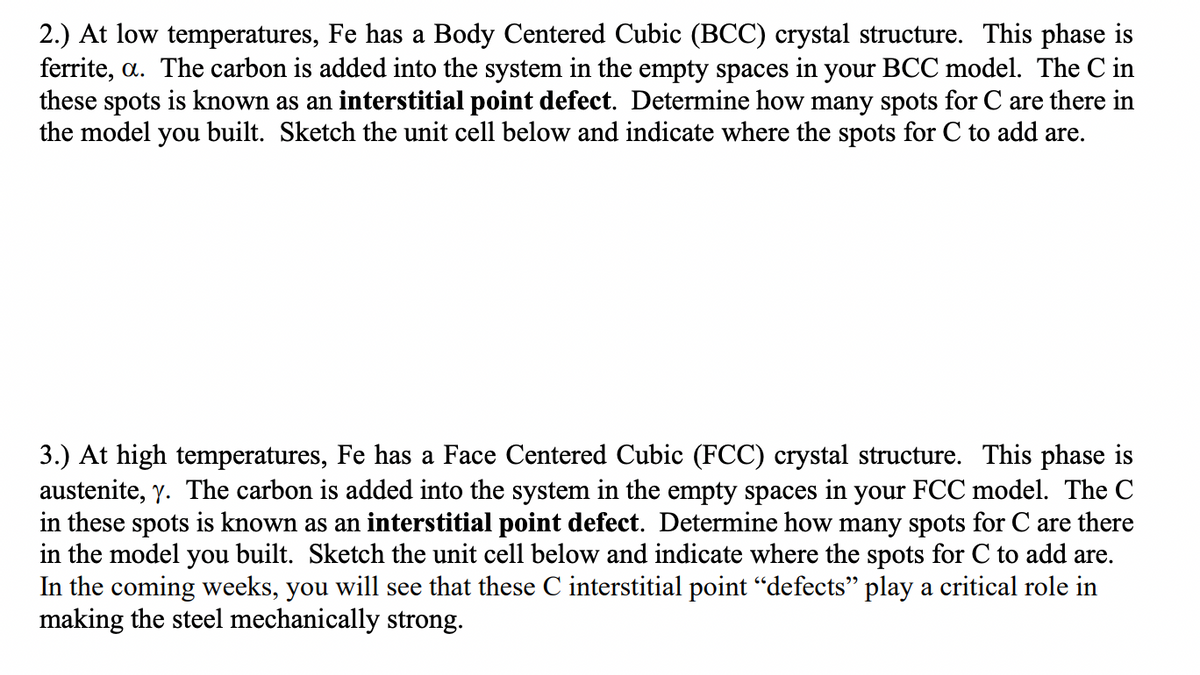At low temperatures, Fe has a Body Centered Cubic (BCC) crystal structure. This phase is rite, a. The carbon is added into the system in the empty spaces in your BCC model. The C in ese spots is known as an interstitial point defect. Determine how many spots for C are there in e model you built. Sketch the unit cell below and indicate where the spots for C to add are.
At low temperatures, Fe has a Body Centered Cubic (BCC) crystal structure. This phase is rite, a. The carbon is added into the system in the empty spaces in your BCC model. The C in ese spots is known as an interstitial point defect. Determine how many spots for C are there in e model you built. Sketch the unit cell below and indicate where the spots for C to add are.
Principles of Modern Chemistry
8th Edition
ISBN:9781305079113
Author:David W. Oxtoby, H. Pat Gillis, Laurie J. Butler
Publisher:David W. Oxtoby, H. Pat Gillis, Laurie J. Butler
Chapter22: Inorganic Materials
Section: Chapter Questions
Problem 7P
Related questions
Question

Transcribed Image Text:2.) At low temperatures, Fe has a Body Centered Cubic (BCC) crystal structure. This phase is
ferrite, a. The carbon is added into the system in the empty spaces in your BCC model. The C in
these spots is known as an interstitial point defect. Determine how many spots for C are there in
the model you built. Sketch the unit cell below and indicate where the spots for C to add are.
3.) At high temperatures, Fe has a Face Centered Cubic (FCC) crystal structure. This phase is
austenite, y. The carbon is added into the system in the empty spaces in your FCC model. The C
in these spots is known as an interstitial point defect. Determine how many spots for C are there
in the model you built. Sketch the unit cell below and indicate where the spots for C to add are.
In the coming weeks, you will see that these C interstitial point "defects" play a critical role in
making the steel mechanically strong.
Expert Solution
This question has been solved!
Explore an expertly crafted, step-by-step solution for a thorough understanding of key concepts.
Step by step
Solved in 3 steps with 3 images

Knowledge Booster
Learn more about
Need a deep-dive on the concept behind this application? Look no further. Learn more about this topic, chemistry and related others by exploring similar questions and additional content below.Recommended textbooks for you

Principles of Modern Chemistry
Chemistry
ISBN:
9781305079113
Author:
David W. Oxtoby, H. Pat Gillis, Laurie J. Butler
Publisher:
Cengage Learning

Physical Chemistry
Chemistry
ISBN:
9781133958437
Author:
Ball, David W. (david Warren), BAER, Tomas
Publisher:
Wadsworth Cengage Learning,

Principles of Modern Chemistry
Chemistry
ISBN:
9781305079113
Author:
David W. Oxtoby, H. Pat Gillis, Laurie J. Butler
Publisher:
Cengage Learning

Physical Chemistry
Chemistry
ISBN:
9781133958437
Author:
Ball, David W. (david Warren), BAER, Tomas
Publisher:
Wadsworth Cengage Learning,